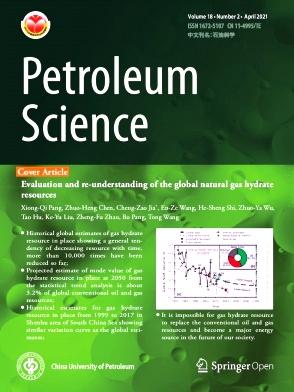Influence of glycol ether additive with low molecular weight on the interactions between CO2 and oil: Applications for enhanced shale oil recovery
IF 6
1区 工程技术
Q2 ENERGY & FUELS
引用次数: 0
Abstract
The high-efficient development of shale oil is one of the urgent problems in the petroleum industry. The technology of CO2 enhanced oil recovery (EOR) has shown significant effects in developing shale oil. The effects of several glycol ether additives with low molecular weight on the interactions between CO2 and oil were investigated here. The solubility of glycol ether additive in CO2 was firstly characterized. Then, the effects of glycol ether additives on the interfacial tension (IFT) between CO2 and hexadecane and the volume expansion and extraction performance between CO2 and hexadecane under different pressures was investigated. The experimental results show that diethylene glycol dimethyl ether (DEG), triethylene glycol dimethyl ether (TEG), and tetraethylene glycol dimethyl ether (TTEG) all have low cloud point pressure and high affinity with CO2. Under the same mass fraction, DGE has the best effect to reduce the IFT between hexadecane and CO2 by more than 30.0%, while an overall reduction of 20.0%–30.0% for TEG and 10.0%–20.0% for TTEG. A new method to measure the extraction and expansion rates has been established and can calculate the swelling factor accurately. After adding 1.0% DEG, the expansion and extraction amounts of CO2 for hexadecane are respectively increased to 1.75 times and 2.25 times. The results show that glycol ether additives assisted CO2 have potential application for EOR. This study can provide theoretical guidance for the optimization of CO2 composite systems for oil displacement.
低分子量乙二醇醚添加剂对二氧化碳与石油之间相互作用的影响:应用于提高页岩油采收率
页岩油的高效开发是石油工业亟待解决的问题之一。二氧化碳提高石油采收率(EOR)技术在页岩油开发中效果显著。本文研究了几种低分子量乙二醇醚添加剂对 CO2 与石油之间相互作用的影响。首先考察了乙二醇醚添加剂在 CO2 中的溶解度。然后,研究了乙二醇醚添加剂对二氧化碳和十六烷之间界面张力(IFT)以及不同压力下二氧化碳和十六烷之间体积膨胀和萃取性能的影响。实验结果表明,二乙二醇二甲醚(DEG)、三乙二醇二甲醚(TEG)和四乙二醇二甲醚(TTEG)都具有较低的浊点压力和较高的二氧化碳亲和性。在相同质量分数条件下,DGE 的效果最好,可将十六烷与 CO2 之间的 IFT 降低 30.0% 以上,而 TEG 和 TTEG 的总体降低率分别为 20.0%-30.0% 和 10.0%-20.0% 。建立了一种测量萃取率和膨胀率的新方法,可以准确计算膨胀因子。加入 1.0% 的 DEG 后,十六烷的膨胀率和二氧化碳萃取率分别提高到 1.75 倍和 2.25 倍。结果表明,乙二醇醚添加剂辅助 CO2 有可能应用于 EOR。该研究可为优化用于石油置换的 CO2 复合系统提供理论指导。
本文章由计算机程序翻译,如有差异,请以英文原文为准。
求助全文
约1分钟内获得全文
求助全文
来源期刊

Petroleum Science
地学-地球化学与地球物理
CiteScore
7.70
自引率
16.10%
发文量
311
审稿时长
63 days
期刊介绍:
Petroleum Science is the only English journal in China on petroleum science and technology that is intended for professionals engaged in petroleum science research and technical applications all over the world, as well as the managerial personnel of oil companies. It covers petroleum geology, petroleum geophysics, petroleum engineering, petrochemistry & chemical engineering, petroleum mechanics, and economic management. It aims to introduce the latest results in oil industry research in China, promote cooperation in petroleum science research between China and the rest of the world, and build a bridge for scientific communication between China and the world.
 求助内容:
求助内容: 应助结果提醒方式:
应助结果提醒方式:


